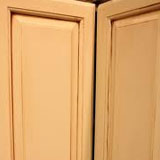LINKS
- Home
- Painting Cabinets Ideas
- Professional Painting Cabinets
- How To Paint Oak Cabinets
- How To Paint Vinyl Cabinets
- Lacquer Paint Cabinets
- Painted Curio Cabinets
- Painted Media Cabinet
- Painted Melamine Cabinets
- Painting Bathroom Cabinets
- Painting Formica Cabinets
- Painting Formica Kitchen Cabinets
- Painting Inside Kitchen Cabinets
- Painting Kitchen Cabinet
- Painting Laminate Cabinets
- Painting Louvered Cabinets
- Painting Metal Cabinets
- Painting Thermofoil Cabinet Doors
- Painting Thermofoil Cabinets
- Painting Veneer Cabinets
- Painting Wood Cabinets
Painting Louvered Cabinets
Painting louvered cabinets is not as easy as painting other kinds of cabinets. In fact, painting louvered cabinets requires extra work including proper preparation and in addition, it is equally important to ensure that the paint is applied to every crook and crevice.
What you need
Here is a list of the things that you need in order to succeed with painting louvered cabinets:
- Sandpaper
- Half inch paint brushes
- Tack rag
- Paint
- Primer
1. Properly prepare the doors
The first step involves proper preparation of the louvered cabinet doors. The simple truth is that painting louvered doors is more complex than painting other cabinet doors. Fixed louvers in particular are very difficult to paint. In case the louvered doors are still bare then it is important to give them a proper sanding without which the paint will not adhere properly when applied. To sand the doors, make use of fine grit sandpaper and do enough with it to create a bare bond paste for priming the doors later on.
2. Eliminate all traces of dust and debris
Once the sanding work has been completed, it is then time to wipe the louvered doors down. Use a tack rag for this, and at the same time also think about vacuuming the doors to remove all traces of dust. After sanding and vacuuming the louvered doors it is then time to check that there is absolutely no trace of dust or debris anywhere on the doors.
3. Apply the primer
It is now time to apply the primer. Start by using a very small sized paintbrush for this task. Paint very small areas when using the paintbrush. Another alternative means of applying primer is to use a spray primer which will give more even as well as uniform coverage. If brushing, thenbe sure to follow the wood grain when applying the brush strokes.
4. Prime top downward
A vast majority of louvered doors face downwards which means that priming should be done from top down and on the outer parts of the door. Be sure to prime in the direction of the grain and also brush along the blades of the shutter. You should prime from the middle of the door and work your way towards the edges and then return from the edges back to the other edge. Do not allow any gaps to remain and paint the inside portion as well. After that, apply the paint to the frame around the blades of the shutter and follow the wood grain when doing so. Allow sufficient time for the primer to dry and then apply the first coat of paint.
5. Apply paint
However, before applying the first coat of paint, you will need to sand the surface a second time. This should be done after the primer has dried out completely. When applying the first coat of paint, use the same technique as was used when applying the primer. The bristles of your paint brush should reach every join and try not to use too much paint on the joints. Be sure to not overload the paint brush as you will be applying a second coat of paint later on.
To apply the second coat, you must first wait for the first coat of paint to dry out completely. Use the same technique when applying the second coat as was used for the first coat.

